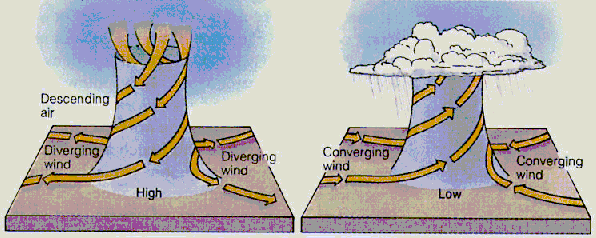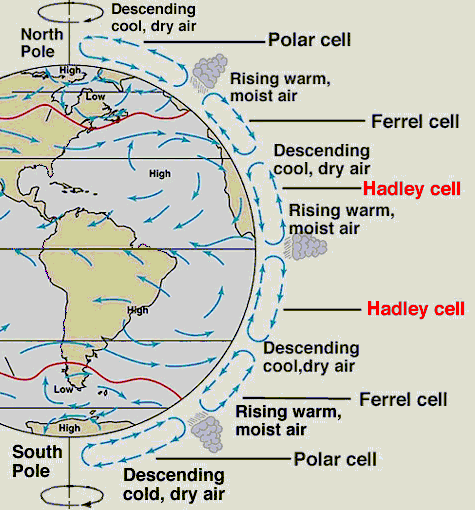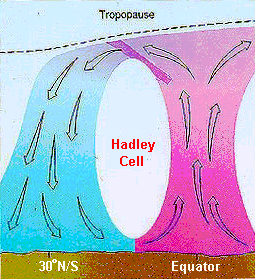Why Are Deserts Dry?
The deserts of the world today are not the deserts of the planet's past. Fossilized hippopotamus and elephant bones tell us that the Sahara, for instance, was a much moister and more hospitable environment around 8,000 years ago than it is now. Scientists do not know exactly how the atmospheric circulation differed at that time, but the advance and retreat of ice sheets are certainly implicated. On longer timescales, plate tectonics have changed the location of biomes. For example, a petrified forest in the Thar Desert, near the town of Jaisalmer, shows that the Indian subcontinental plate once lay at more equatorial latitudes.
Each of the Earth's modern deserts are a consequence of one of the following mechanisms:
- Air mass subsidence (subtropical and polar deserts, e.g., Sahara and Antarctica);
- Rain shadows (e.g., Mojave);
- Distant moisture sources (e.g., Gobi);
- Cold offshore sea-surface temperatures (e.g., Atacama).
Air Mass Subsidence
Most of us are intimately familiar with the mostly-horizontal aspects of the atmosphere's general circulation, which we perceive as “weather.” But there is also a vertical component to this general circulation – enormous cells that have vertical motions of just a few centimeters per hour. The Earth's atmosphere is heated from the planet's surface, and these cells are driven by differences in the amount of solar radiation reaching the surface at various latitudes. The principal cells are the Hadley and Polar cells, while the Ferrell cell is the consequence of atmospheric dynamics rather than surface heating. The graphics below shows these three vertical cells and the vertical circulation of the Hadley cell.
Now, ascending air cools, and cool air is able to hold less moisture than warm air. Thus, convective storms form readily under the rising branch of the Hadley cell. Conversely, descending air (whether at subtropical or polar latitudes) both dynamically suppresses convection and warms, as the graphic below shows. (In meteorology, such descending air is said to be subsiding.) Because warmer air is able to hold more moisture, any cloud formation becomes a remote possibility.

Rain Shadows
A similar mechanism operates to squeeze moisture out of air masses that cross mountain ranges. As the topography forces air to rise, the air cools. Once the air reaches its lifting condensation level, clouds form and the moisture in the air mass falls as rain or snow. Higher and broader mountain ranges form barriers beyond which little precipitation ever falls. For example, Nevada's Great Basin desert is dry because next-to-all moisture is squeezed out of wet Pacific air masses as they cross the barriers of the Coast Range, the Sierra Nevada, and finally the White Mountains. Australia's Great Basin is similarly dry because of the Great Dividing Range, while the cold deserts of Tibet and India's Ladakh are dessicated by the Himalayas.
Distant Moisture Sources
The vast drylands of Central Asia are the result of moisture falling from air masses prior to their arrival. While some percentage of this moisture will be evapotranspirated back into the atmosphere to fall farther inland, much is transported out by rivers or stored in groundwater. Inland continental regions are thus inexorably deprived of moisture-laden air.
Cold Offshore Sea-Surface Temperatures
The argument that cool air is able to hold less moisture than warm air should by now be familiar. The atmosphere's general circulation and the Coriolis force combine to push shallow surface waters along the west coasts of the Americas, Australia, and Africa away from land. This water must be replaced, and the only source of replacement is the deep, cold water from far below the surface. While the nutrient richness of the upwelling water impels the bounty of coastal fisheries, its coldness causes the formation of the coastal fogs that are especially well-known in densely-populated California. The air masses crossing the coasts are thus both dry and cold by the time they arrive over land.
The correct citation for this document is:
Milich, L., 1997. Why are deserts dry? http://ag.arizona.edu/~lmilich/dry.html.
 Back
Back
(Image sources: http://ess.geology.ufl.edu/ess/Notes/AtmosphericCirculation/atmosphere.html)
This site last updated June 14, 1997.





 Back
Back